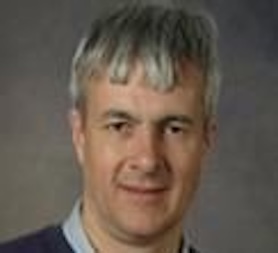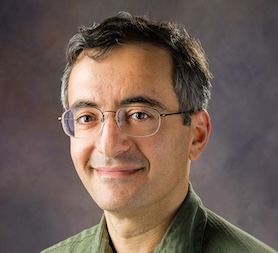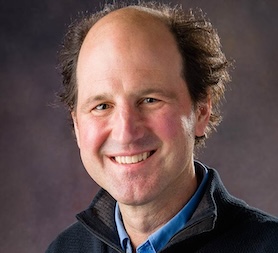
Stephen Lockett, Ph.D.
Director, OMAL
301-846-5515
Background
Stephen Lockett received the Ph.D. degree from the Department of Medicine, Birmingham University, England. His research interests include fluorescence microscopy and the development of analysis software for extracting quantitative information from images. He has published over 120 research papers and has received several international awards.
Selected Publications
Coexpression of NOS2 and COX2 accelerates tumor growth and reduces survival in estrogen receptor-negative breast cancer. Basudhar D, Glynn SA, Greer M, Somasundaram V, No JH, Scheiblin DA, Garrido P, Heinz WF, Ryan AE, Weiss JM, Cheng RYS, Ridnour LA, Lockett SJ, McVicar DW, Ambs S, Wink DA. Proc Natl Acad Sci U S A. 2017 Dec 5;114(49):13030-13035. doi: 10.1073/pnas.1709119114. Epub 2017 Oct 27. PMID: 29087320
Graphcut Based 3D Nuclear Segmentation in Optical Microscopy Tissue Images. Kaustav Nandy, Rama Chellappa and Stephen J Lockett. IEEE Selected Topics in Signal Processing Special Issue on Advanced Signal Processing in Microscopy and Cell Imaging. 2016, Volume: 10, Issue: 1 Pages: 140 – 150, DOI: 10.1109/JSTSP.2015.2505148.
Quantitative Analysis of F-Actin Redistribution In Astrocytoma Cells Treated With Candidate Pharmaceuticals. Stephen Lockett, Chrissie Verma, Alla Brafman, Prabhakar Gudla, Kaustav Nandy, Yoshihiro Mimaki, Philip L. Fuchs, Joseph Jaja, Karlyne M. Reilly, John Beutler, Thomas J. Turbyville. Cytometry Part A, 2014 Jun;85(6):512-21.
3D Image Analysis of Thick Breast Cancer Specimens show High Cell-to-Cell Genetic Heterogeneity. Chin K, Ortiz de Solorzano C, Knowles D, Jones A, Chou W, Rodriguez EG, Kuo WL, Ljung BM, Chew K, Myambo K, Miranda M, Krig S, Garbe J, Stampfer M, Yaswen P, Gray JW, Lockett SJ. Nature Genetics, 36:984-988,2004.

Valentin Magidson, Ph.D.
Scientist
301-846-6092
Background
Valentin Magidson received his Ph.D. degree from the Department of Physics, Technion, Israel. Prior to joining the OMAL team, his research focused on laser-based microscopy techniques, which he applied to both the physics of semiconductors and the biology of cell division. His current focus is on optical super-resolution techniques, including the recently emerged tool of expansion microscopy.
Selected Publications
Adaptive changes in the kinetochore architecture facilitate proper spindle assembly. Magidson V, Paul R, Yang N, Ault JG, O’Connell CB, Tikhonenko I, McEwen BF, Mogilner A, Khodjakov A. Nature Cell Biology 17(9): 1134-44, 2015
A The spatial arrangement of chromosomes during prometaphase facilitates spindle assembly. Magidson V, O’Connell CB, Loncarek J, Paul R, Mogilner A, and Khodjakov. Cell 146(4):555-67, 2011
Regulation of cytokinesis by spindle-pole bodies. Magidson V, Chang F, and Khodjakov A. Nature Cell Biology 8(8): 891-3, 2006
Fano-type interference in the Raman spectrum of photoexcited Si. Magidson V and Beserman R. Physical Review B 66 (19): Art. No. 195206, 2002

Will Heinz, Ph.D.
Scientist
301-846-1239
Background
Will Heinz received his Ph.D. from the department of Biophysics and Biophysical Chemistry at Johns Hopkins University School of Medicine. His research interests include biological atomic force microscopy and developing in vitro tools, microscopy techniques, and analytical methods to investigate the immunosuppressive tumor microenvironment. Before joining OMAL, he developed protein micropatterning techniques for cell-based applications, one of which he patented and commercialized.
Selected Publications
An in vitro tumorigenesis model based on live cell-generated oxygen and nutrient gradients. Gilmore, A. C., Flaherty, S. J., Somasundaram, V., Scheiblin, D. A., Lockett, S. J., Wink, D. A., & Heinz, W. F. (2020). BioRxiv, 2020.08.24.264580. https://doi.org/10.1101/2020.08.24.264580
Truncated Tetrahedral RNA Nanostructures Exhibit Enhanced Features for Delivery of RNAi Substrates. Zakrevsky, P., Kasprzak, W. K., Heinz, W. F., Wu, W., Khant, H., Bindewald, E., Dojsuren, N., Eric A, F., de Val, N., Jaeger, L., & Shapiro, B. A. (2020). Nanoscale, 12(4), 2555–2568. https://doi.org/10.1039/c9nr08197f
Inducible nitric oxide synthase-derived extracellular nitric oxide flux regulates proinflammatory responses at the single cell level. Somasundaram, V., Gilmore, A. C., Basudhar, D., Palmieri, E. M., Scheiblin, D. A., Heinz, W. F., Cheng, R. Y. S., Ridnour, L. A., Altan-Bonnet, G., Lockett, S. J., McVicar, D. W., & Wink, D. A. (2020). Redox Biology, 28, 101354. https://doi.org/10.1016/j.redox.2019.101354
Density of σ70 promoter-like sites in the intergenic regions dictates the redistribution of RNA polymerase during osmotic stress in Escherichia coli. Sun, Z., Cagliero, C., Izard, J., Chen, Y., Zhou, Y. N., Heinz, W. F., Schneider, T. D., & Jin, D. J. (2019). Nucleic Acids Research, 47(8), 3970–3985. https://doi.org/10.1093/nar/gkz159
Full PubMed Summary
OMAL Post-Bac Alumni
Giana Vitale
Rebecca Moffat
Favour Nwagugo
Sneha Anmalsetty–Lewis Katz School of Medicine at Temple University
Sally Feng–Institute for Biomedical Sciences, George Washington University School of Medicine and Health Sciences
Sarah Flaherty–University of Maryland School of Medicine
Erina Kamiya–Weill Cornell Graduate School of Medical Sciences
Caroline Gilmore–St. Jude Children’s Research Hospital Graduate School of Biomedical Sciences
Matthew Bowler–University of North Carolina Eshelman School of Pharmacy